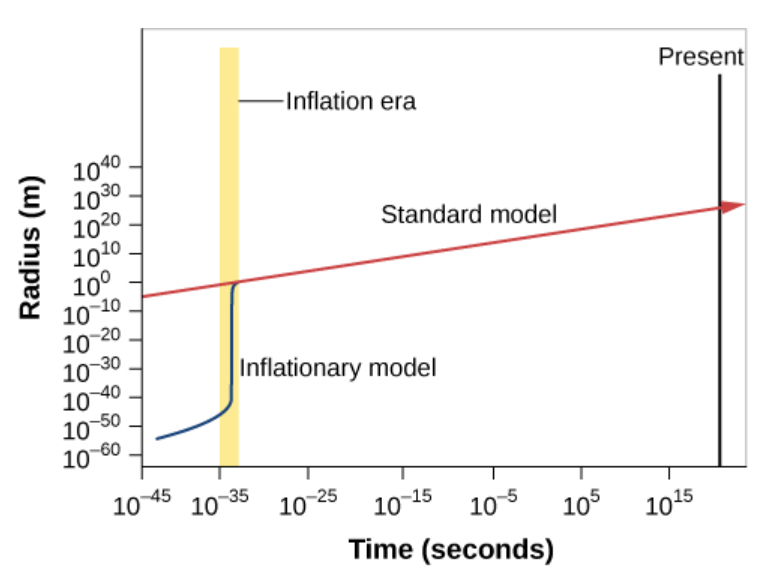chapter 29.4 the cosmic microwave background & 29.5 what is the universe made of? & the inflationary universe & 29.7 the anthropic principle
1/10
There's no tags or description
Looks like no tags are added yet.
Name | Mastery | Learn | Test | Matching | Spaced |
|---|
No study sessions yet.
11 Terms
transparent universe
few hundred years after Big Bang
temperature dropped to 3000K and the density of atomic nuclei was about 1000 per cubic cm
electrons and nuclei able to combine to form stable atoms of hydrogen and helium
thus no free electrons to scatter photos, the universe became transparent
matter and radiation thus interacted much less frequently; we say that they decoupled from each other and evolved separately (photon decoupling time)
electromagnetic radiation could thus travel
cosmic microwave background
faint afterglow of radio waves
3K microwave background (2.73K)
radiation coming from all directions (isotropic)
allowed us to determine that the universe today evolved from a hot, uniform state
sizes and cold spots in the CMB depend on the geometry of the universe
basic properties of the universe
Age of universe: 13.799±0.03813.799±0.038 billion years (Note: That means we know the age of the universe to within 38 million years. Amazing!)
Hubble constant: 67.31±0.9667.31±0.96 kilometers/second/million parsecs (in the units we’ve been using, 20.65 kilometers/second/million light-years)
Fraction of universe’s content that is “dark energy”: 68.5%±1.3%68.5%±1.3%
Fraction of the universe’s content that is matter: 31.5%±1.3%
Analysis of Planck data also shows that ordinary matter (mainly protons and neutrons) makes up 4.9% of the total density.
Dark matter plus normal matter add up to 31.5% of the total density.
Dark energy contributes the remaining 68.5%.
The age of the universe at decoupling—that is, when the CMB was emitted—was 380,000 years.
300-400 million years after Big Bang
stars and galaxies had formed
compositions of the universe
Luminous matter in stars and galaxies and neutrinos contributes about 1% of the mass required to reach critical density.
Another 4% is mainly in the form of hydrogen and helium in the space between stars and in intergalactic space.
Dark matter accounts for about an additional 27% of the critical density.
The mass equivalent of dark energy (according to E = mc2) then supplies the remaining 68% of the critical density.

dark matter
one class: WIMPs;
do not participate in nuclear reactions leading to the production of deuterium, the deuterium abundance puts no limits on how many WIMPs might be in the universe
inflationary universe
Some physicists suggested that these fundamental characteristics of the cosmos—its flatness and uniformity—can be explained if shortly after the Big Bang (and before the emission of the CMB), the universe experienced a sudden increase in size.
A model universe in which this rapid, early expansion occurs is called an inflationary universe
The inflationary universe is identical to the Big Bang universe for all time after the first 10–30 second.
Prior to that, the model suggests that there was a brief period of extraordinarily rapid expansion or inflation, during which the scale of the universe increased by a factor of about 1030 times more than predicted by standard Big Bang models
Prior to (and during) inflation, all the parts of the universe that we can now see were so small and close to each other that they could exchange information, that is, the horizon distance included all of the universe that we can now observe.
Before (and during) inflation, there was adequate time for the observable universe to homogenize itself and come to the same temperature.
Another appeal of the inflationary model is its prediction that the density of the universe should be exactly equal to the critical density.


grand-unified theories (GUTs)
forces of gravity and electromagnetism behaved very differently in the extreme conditions of the early universe
all physical processes can be described through the action of 4 forces: gravity, electromagnetism, the strong nuclear force, and the weak nuclear force
In these theories, the strong, weak, and electromagnetic forces are not three independent forces but instead are different manifestations or aspects of what is, in fact, a single force.
The theories predict that at high enough temperatures, there would be only one force.
Planck time
universe from time 0 to 10^-43 second
universe was unimaginably hot and dense
quantum effects of gravity dominated physical interactions
when did the 4 forces of the universe become distinct?
temperature was down to 1015 K and the universe was 10–10 second old.
anthropic principle
that the physical laws we observe must be what they are precisely because these are the only laws that allow for the existence of humans